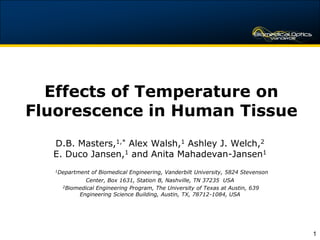
Effects of Temperature on Fluorescence in Human Tissue
- 1. Effects of Temperature on Fluorescence in Human Tissue D.B. Masters,1,* Alex Walsh,1 Ashley J. Welch,2 E. Duco Jansen,1 and Anita Mahadevan-Jansen1 1Department of Biomedical Engineering, Vanderbilt University, 5824 Stevenson Center, Box 1631, Station B, Nashville, TN 37235 USA 2Biomedical Engineering Program, The University of Texas at Austin, 639 Engineering Science Building, Austin, TX, 78712-1084, USA 1
- 2. Disclosures No disclosures. Investigational research: not FDA approved. No off label uses. 2
- 3. Motivation Applications • Fluorescence for therapy guidance/ diagnosis ─ Procedures with variable temperature • RFA/microwave ablation • Electrocauterization • Laser ablation 3
- 4. Background • Fluorescence intensity and temperature – Usually inversely related – Depends on substance • Tissue – Small temperature range Goal: – Very complex Examine mechanism of • Optical property changes fluorescence change due – Causes to temperature: • Coagulation • Dehydration 1. Optical Properties • Denaturation 2. Fluorophore – Modulate fluorescence emission degradation • Other possible mechanisms − Loss of cell viability − Collisional quenching 4
- 5. Materials & Methods: In vitro Materials • Human Tissue Samples: – From liposuction and breast reduction surgeries – Skin • Flash frozen samples Methods Passively warmed (to 23°C ) Fluorescence and Actively heated (to 50°C or 70°C) Temperature acquired every 2.5°C Allowed to cool (to 23°C) 5
- 7. Data Processing For every temperature, approximately • Reflectance data used in every 2.5°C. inverse Monte Carlo λ : 400-800 nm µs ’ algorithm as input Inverse • Output: µa, µs’ Rd Monte Carlo1 µa Spectra Spectral •Fluorescence max. (Fl., Rd.) Processing intensity as a function of temperature Spectral Max. Fl. Analysis Intensity • Normalized so that peak intensity at 23°C was equal to 1. 1Palmer, G.M. Appl. Opt., 2006. 45(5): p. 1062- 1071. 7
- 8. Results Skin 1.4 65 3 Average (n=8) 1.3 2.8 St. Dev. 60 2.6 1.2 Fl. Peak Height (a.u.) 2.4 1.1 55 2.2 (cm-1) (cm-1) 1 50 2 0.9 a s 1.8 0.8 45 1.6 0.7 1.4 40 0.6 1.2 0.5 35 1 0 20 40 60 80 0 20 40 60 80 0 20 40 60 80 temperature C • Consistent fluorescence decrease •Optical property changes do not explain fluorescence decrease 8
- 9. Results: Reversibility Skin Reversibility 1.4 Average (n=8) St. Dev. 1.3 Cooling: Max. Temp. 70 C (n=4) Cooling: Max. Temp. 50 C (n=4) •All skin samples showed 1.2 some reversibility 1.1 •Hysteresis expected Fl. Peak Height (a.u.) 1 0.9 0.8 0.7 0.6 0.5 0 10 20 30 40 50 60 70 80 temperature C 9
- 10. Conclusions: In Vitro Fluorescence intensity decreases with increasing temperature in human tissue Optical properties do not explain fluorescence decrease at 20°C-50°C Fluorophore degradation above a certain temperature 10
- 11. Materials & Methods: In vivo Materials • Human lateral forearm • 7 volunteers Methods Cooled Skin with Ice Pack Skin Passively Warms to Body Temp. Heated Skin with Heat Pack Skin Passively Cools to Body Temp. 11
- 12. Results: In Vivo In Vivo Skin • Fluorescence Average (n=7) St. Dev. decrease is 1.2 reproduced in vivo – No damage 1.1 Fl. Peak Height (a.u.) – Completely 1 reversible 0.9 0.8 0.7 0.6 10 15 20 25 30 35 temperature ( C) 12
- 13. In Vivo: Conclusions Fluorescence decrease can be reproduced in vivo No damage or coagulation Reversible 13
- 14. Conclusions In vitro •Fluorescence intensity decreases with increasing temperature in human tissue •Optical properties do not cause fluorescence decrease from 20°C to 50°C In vivo •Fluorescence decrease can be reproduced in vivo •No damage •Reversible Overall In human tissue, optical properties and tissue damage are not the only factors that cause a change in fluorescence due to temperature. 14
- 15. Acknowledgements •All the members of the Biomedical Optics Lab •Raiyan Zaman at the University of Texas at Austin •NIH R21 CA 133477 •USAF Grant for Graduate Students and Post-Doctoral Fellows Currently Involved Full- Time in Biomedical Laser Research travel grant 15
Editor's Notes
- Mention assumption of specimen equilibrium to waterMention below photobleaching thresholdEffect of PBS experiment shows no effect.
- Redo scale on figures
- align